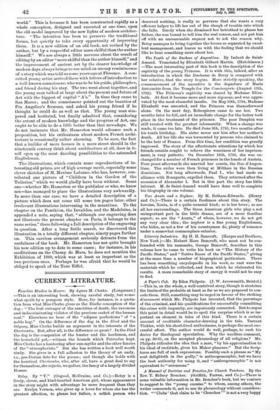The Youth of the Duchess of Angouleme. By Imbert de
Saint- Amend. Translated by Elizabeth Gilbert Martin. (Hutchinson.) —The most interesting part of this book is the description of the captivity of the young Princess. It is with this, indeed, after an introduction in which the Duchesse de Berry is compared with her relative, that the story begins. More strictly speaking, the commencement of the narrative is the departure of Marie Antoinette from the Temple for the Conciergerie (August 13th, 1792). The Princess's captivity was shared by Madame Eliza- beth. At first it became more and more rigorous, and was aggra- vated by the most shameful insults. On May 10th, 1794, Madame Elizabeth was executed, and the Princess was thenceforward alone. On the next day, Robespierre came to see her. Two months later he fell, and an immediate change for the better took place in the treatment of the prisoner. The poor Dauphin was still treated with the greatest inhumanity. When a change was made, it came too late. Be died June 9th, 1795, two months after his tenth birthday. His sister never saw him after her mother's death. All her life she was tormented by persons who claimed to be the heir of France. From this time, her condition was greatly improved. The story of the affectionate attentions by which her friends outside sought to relieve the weariness of her imprison- ment, is very pathetic. On December 18th, 1795, she was ex- changed for a number of French prisoners in the hands of Austria. Four years afterwards she married her cousin, the Due d'Angott- leme. The exiles were then living at Milthau in the Russian dominions. Not long afterwards, Paul I., who had made an alliance with Bonaparte, expelled them. They returned after the accession of Alexander I. But in this part the story has little interest. M. de Saint-Amend would have done well to complete his biography in one volume.


















































 Previous page
Previous page